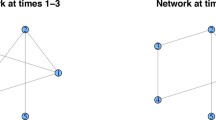Abstract
Discovering regulatory interactions from time-course gene expression data constitutes a canonical problem in functional genomics and systems biology. The framework of graphical Granger causality allows one to estimate such causal relationships from these data. In this study, we propose an adaptively thresholding estimates of Granger causal effects obtained from the lasso penalization method. We establish the asymptotic properties of the proposed technique, and discuss the advantages it offers over competing methods, such as the truncating lasso. Its performance and that of its competitors is assessed on a number of simulated settings and it is applied on a data set that captures the activation of T-cells.
Similar content being viewed by others
References
Arnold A, Liu Y, Abe N (2007) Temporal causal modeling with graphical granger methods. In: Proceedings of the 13th ACM SIGKDD, pp 66–75
Basu S, Shojaie A, Michailidis G (2011) Incorporating group structure in estimation of graphical Granger causality. Tech rep, Department of Statistics, University of Michigan
Bickel P, Ritov Y, Tsybakov A (2009) Simultaneous analysis of lasso and Dantzig selector. Ann Stat 37(4):1705–1732
Fujita A, Sato J, Garay-Malpartida H, Yamaguchi R, Miyano S, Sogayar M, Ferreira C (2007) Modeling gene expression regulatory networks with the sparse vector autoregressive model. BMC Syst Biol 1(1):39
Granger C (1969) Investigating causal relations by econometric models and cross-spectral methods. Econometrica, 424–438
Lozano A, Abe N, Liu Y, Rosset S (2009) Grouped graphical Granger modeling for gene expression regulatory networks discovery. Bioinformatics 25(12):i110
Lütkepohl H (2005) New introduction to multiple time series analysis. Springer, Berlin
Meinshausen N, Yu B (2009) Lasso-type recovery of sparse representations for high-dimensional data. Ann Stat 37(1):246–270
Mukhopadhyay N, Chatterjee S (2007) Causality and pathway search in microarray time series experiment. Bioinformatics 23(4):442
Murphy K (2002) Dynamic Bayesian networks: representation, inference and learning. PhD thesis, University of California
Ong I, Glasner J, Page D et al. (2002) Modelling regulatory pathways in E. coli from time series expression profiles. Bioinformatics 18(Suppl 1):S241–S248
Opgen-Rhein R, Strimmer K (2007) Learning causal networks from systems biology time course data: an effective model selection procedure for the vector autoregressive process. BMC Bioinform 8(Suppl 2):S3
Pearl J (2000) Causality: models, reasoning, and inference. Cambridge University Press, Cambridge
Perrin B, Ralaivola L, Mazurie A, Bottani S, Mallet J, d’Alche Buc F (2003) Gene networks inference using dynamic Bayesian networks. Bioinformatics 19(Suppl 2):138–148
Rangel C, Angus J, Ghahramani Z, Lioumi M, Sotheran E, Gaiba A, Wild D, Falciani F (2004) Modeling t-cell activation using gene expression profiling and state-space models. Bioinformatics 20(9):1361
Raskutti G, Wainwright MJ, Yu B (2010) Restricted eigenvalue properties for correlated Gaussian designs. J Mach Learn Res 11:2241–2259
Shojaie A, Michailidis G (2010) Discovering graphical Granger causality using the truncating lasso penalty. Bioinformatics 26(18):i517–i523
Shojaie A, Michailidis G (2010) Penalized likelihood methods for estimation of sparse high-dimensional directed acyclic graphs. Biometrika 97(3):519–538
van de Geer SA, Bühlmann P (2009) On the conditions used to prove oracle results for the lasso. Electron J Stat 3:1360–1392
Wasserman L, Roeder K (2009) High dimensional variable selection. Ann Stat 37(5A):2178
Yamaguchi R, Yoshida R, Imoto S, Higuchi T, Miyano S (2007) Finding module-based gene networks with state-space models-Mining high-dimensional and short time-course gene expression data. IEEE Signal Process Mag 24(1):37–46
Zhou S (2010) Thresholded lasso for high dimensional variable selection and statistical estimation. Preprint arXiv:1002.1583
Author information
Authors and Affiliations
Corresponding author
Rights and permissions
About this article
Cite this article
Shojaie, A., Basu, S. & Michailidis, G. Adaptive Thresholding for Reconstructing Regulatory Networks from Time-Course Gene Expression Data. Stat Biosci 4, 66–83 (2012). https://doi.org/10.1007/s12561-011-9050-5
Received:
Accepted:
Published:
Issue Date:
DOI: https://doi.org/10.1007/s12561-011-9050-5




